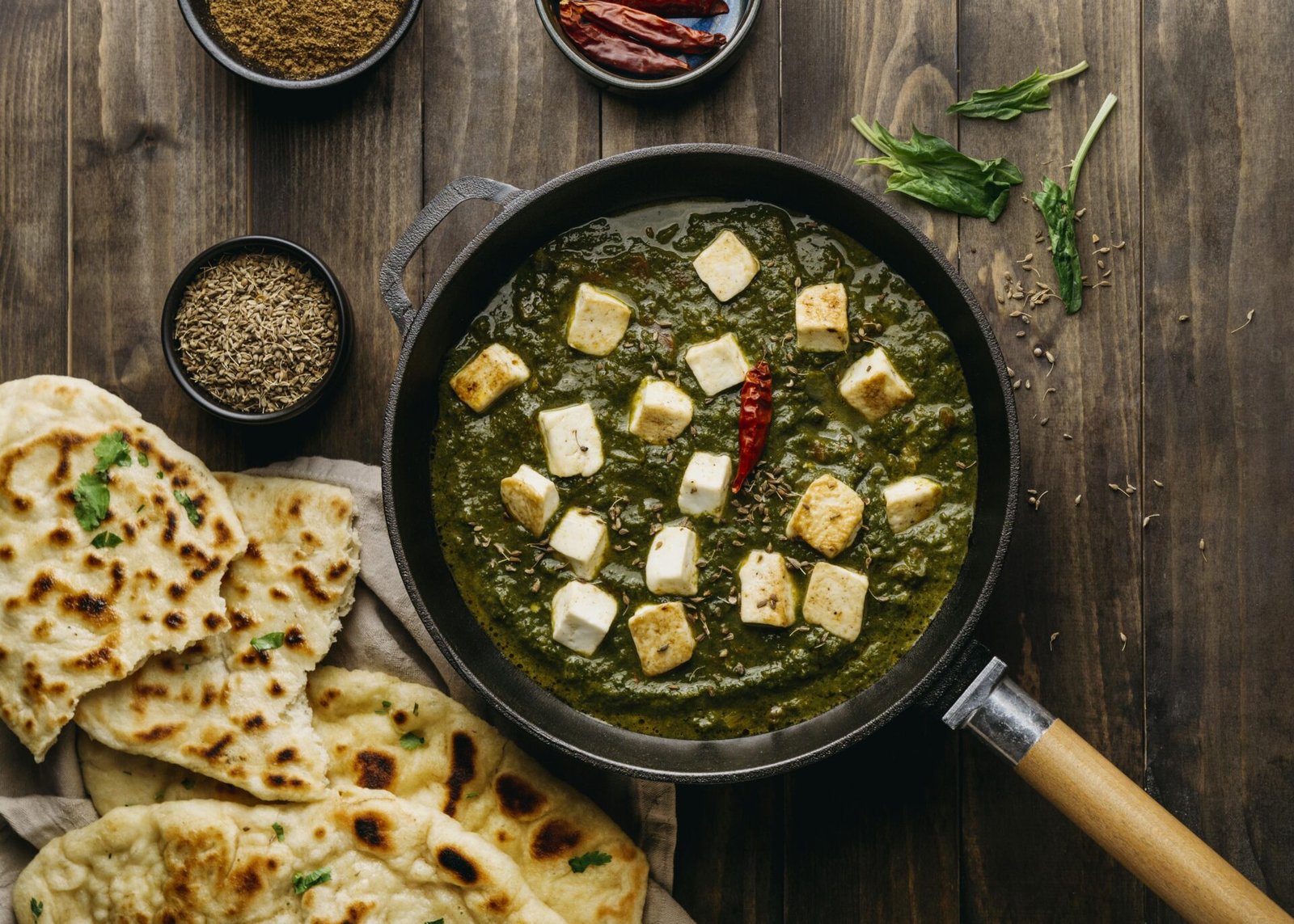Saag

Saag is a traditional Punjabi dish made from leafy greens like spinach, mustard saag, or fenugreek leaves, cooked with aromatic spices and served with breads like roti or naan Here is a detailed knowledge of how to make saag:
Ingredients:
– 500 grams fresh spinach leaves (or a combination of spinach and mustard greens/fenugreek leaves)
– 2 tablespoons ghee or oil
– 1 onion, finely chopped
– 2 tomatoes, finely chopped
– 2-3 green chilies, finely chopped (adjust according to taste)
– 1 tablespoon ginger-garlic paste
– 1 teaspoon cumin seeds
– 1 teaspoon ground coriander
– 1 teaspoon ground cumin
– 1/2 teaspoon turmeric powder
– 1/2 teaspoon red chili powder (adjust to taste)
– Salt, to taste
– 1/2 cup plain yogurt (optional)
– Fresh cilantro leaves, for garnish
Equipment:
– Large pot or saucepan
– Blender or immersion blender
– Wooden spoon
– Knife and chopping board
Instructions:
Prepare the Greens:
1. Rinse spinach leaves (and mustard greens or fenugreek, if using) to eliminate any dirt from them as much as possible. Drain excess water.
2. If the spinach leaves are big then it is preferred that you tear them into smaller parts so that the heat can spread through well.
Cook the Saag:
1. In a large pot or saucepan heat ghee or oil till its shimmering on medium heat.
2. Initially, include cumin seeds in the hot ghee/oil and cook for several seconds when it begins to crackle.
3. Fry onions in the pot till they turn light brown in colour and slightly tender, then pour in water.
4. Chop the ginger garlic and green chilies and add to the above mixture and sauté for a couple of minutes more.
5. Next, put the chopped tomatoes into the pot; let them cook down until you have a thick purple masala.
6. After that, you need to put ground coriander, cumin, turmeric powder, red chili powder, and salt into the pot. Stir the spices into the base of the masala, for a homogenized consistency.
7. Some of the greens that are commonly used include the spinach, silverbush and the Ethiopia lettuce; Chop them and wash them, then add them into the pot. Stir with bonnet well to ensure that the greens are coated with the spice mixture.
8. Place the lid on the pot and allow the greens to simmer for another 10-15 minutes, using a spoon or spatula to occasionally turn the greens around in the pot in order to prevent burning or sticking to the bottom of the pot as the greens cooks and wilts.
Blend the Saag:
1. Aftercooking the greens, the pot shouldbe taken off the heat and allowed to cool down.
2. In order to attain a smooth consistency, purée the cooked greens with a blender, or an immersion blender. The saag can be processed to the desired thinness – for some, the soup is soupy and smooth while for others it has an order of chunkiness.
3. If using yogurt, you can add it to the blended saag and stir mix to ensure that it blends properly with the rest of the mixture. This makes the dish depend on a creamy texture some sourness, and comes as a second sauce.
Finish the Saag:
1. Put the blended saag back into the pot and simmer it over low heat while you continue with the next process.
2. Let the greens roast for a few minutes, the flavors melt and the thickness hardens a bit.
3. Taste the vegetables and adjust seasonings if necessary, adding more salt or seasoning to taste.
Serve the vegetables:
1. Once the greens are cooked to your liking, remove from the heat and place in a serving bowl.
2. Garnish the leaves with fresh cilantro leaves for a pop of color and serve with fresh.
3. Serve hot with bread, naan and rice along with the greens for a comforting and nutritious meal.
tip
-You can adjust the amount of spice in the greens by adding more or less green chilli and red chilli powder as per your taste.
– You can add a dollop of cream or butter before serving to give greens a thicker and creamier texture.
-The remaining greens can be stored in an airtight container in the refrigerator for up to 3-4 days. Rewarm gently in the oven or microwave before serving.
– The greens taste even better the next day as the flavors have had time to develop and integrate.
– Feel free to switch up the greens by adding other ingredients like paneer (Indian cottage cheese), tofu, or cooked lentils for extra protein and texture.
Enjoy your homemade saag, a typical Punjabi dish that is sweet, tasty and nutritious!
Calories in Saag
Saag is a traditional Punjabi dish made of green vegetables like spinach, mustard greens, or fenugreek leaves, cooked with aromatic spices, has a rich history and offers many health benefits Let’s explore both:
History:
1. Indian origin: The green legume originates in the Indian subcontinent, mainly in Uttar Pradesh of Punjab, where it originated. The dish has been a staple of Punjabi cuisine for centuries, with variations and local adaptations over time.
2. Agricultural Influence: Known as the “bread basket of India”, Punjab is a fertile agricultural land with green leaves like spinach, mustard, fenugreek leaves etc. dish for homes.
3. Cultural Significance: Saag has cultural significance in Punjabi cuisine and is often associated with warmth, comfort and hospitality. It’s a meal that brings families together, especially in the winter months when fresh greens abound and hearty dishes are served.
2. Digestive health: The fiber in leafy greens helps support digestive health by maintaining regular bowel movements, preventing constipation and supporting gut health. Regular consumption of leafy greens as part of a balanced diet can aid digestion and improve both stomach and intestinal health.
3. Heart Health: Leafy greens are low in fiber and fat but high in fiber and other heart healthy nutrients. Regular consumption of green leafy vegetables can lower cholesterol, lower blood pressure and support cardiovascular health, thus reducing the risk of heart attack and stroke on the snow
4. Weight management: Greens are a low-calorie and nutrient dense food that can be added to a weight loss or weight management diet. The high fiber content of greens helps satiety, making you feel fuller and more satisfied for longer, which can help with weight loss and weight maintenance efforts
5. Immune boosters: Leafy greens are rich in vitamin C and beta-carotene, which help strengthen and protect the immune system from oxidative stress and inflammation include greens included in your diet to enhance your body’s natural defenses and help support overall health overall health . as .
6. Bone Health: Leafy greens are a good source of vitamin K, which plays an important role in bone health and calcium absorption. Regular consumption of greens can improve bone density, reduce your risk of osteoporosis, and support overall bone health, especially as you age.
7. Versatility: Greens are a versatile food that can be tailored to individual preferences and dietary needs. You can use different greens, spices and other ingredients to create different flavors and textures, making it suitable for vegetarians, vegans and vegetarians
Overall, greens are not only delicious and comforting, but also a nutritious addition to any meal. Enjoy with roti, naan and rice, the greens are a timeless classic offering countless health benefits and cultural meanings.
